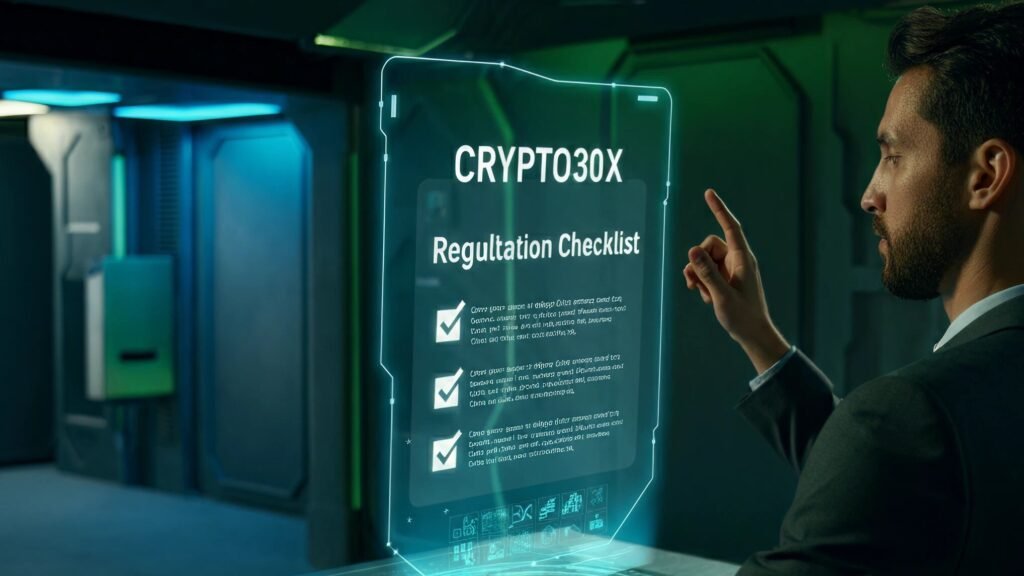Introduction
When you search for crypto30x.com regulation, you’re asking a vital question about how this platform fits into the broader legal and compliance landscape. For anyone considering using this high-yield crypto service, regulation is more than a buzzword—it’s the foundation of trust, safety, and legitimacy. This article will examine crypto30x.com regulation in depth, unpacking its current status, potential risks, comparisons with industry standards, and what investors need to know to use it confidently and responsibly.
1. Setting the Stage: Why crypto30x.com regulation Matters
Regulation in the crypto space serves two key functions: protecting users and ensuring market integrity. Platforms promising ambitious returns, like the so-called “30x upside,” are especially significant from a regulatory standpoint. Without a clear framework, crypto30x.com regulation becomes essential for:
- Verifying whether the platform operates under recognized legal jurisdictions.
- Confirming adherence to anti-money laundering (AML) and know-your-customer (KYC) rules.
- Identifying consumer protections or guarantees, if any exist.
- Ensuring transparency in fund handling, fee structures, and dispute mechanisms.
For users, answers to crypto30x.com regulation questions determine whether the platform operates under solid legal footing or remains a speculative venture in uncharted territory.
2. Jurisdiction: Where Does crypto30x.com regulation Apply?
To grasp crypto30x.com regulation, it’s crucial to know which legal jurisdictions the platform acknowledges:
- Incorporation location: The company’s place of incorporation influences its regulatory obligations and governing laws.
- User residency policies: Some platforms restrict access based on local crypto regulations. If crypto30x.com regulation excludes U.S. or EU users, it signals regulatory caution.
- Declared legal compliance: Does the platform mention specific oversight bodies, such as a financial authority in its country of registration?
If crypto30x.com regulation is limited to unregulated or lax jurisdictions, users may face legal ambiguity and lack formal protections.
3. Licensing and Registration: Formal Recognition vs. Self-Regulation
One of the most telling signs of crypto30x.com regulation maturity is proper licensing:
- Financial service licensing: Does the platform hold a license to act as a custodian, exchange, or investment vehicle?
- Exchange or broker oversight: Are there references to a recognized securities commission or financial regulator?
- Oversight status: Even partial disclosure—such as registration with a financial authority—adds legitimacy.
Without licensing, crypto30x.com regulation remains murky, and customers may struggle to resolve disputes or recover assets if something goes wrong.
4. AML and KYC Measures: Are They Part of crypto30x.com regulation?
Every reputable platform includes anti-money laundering and know-your-customer processes. Here’s what to look for in crypto30x.com regulation:
- Mandatory verification paths: Users may need to submit photo ID, proof of address, or other documentation.
- Transparent AML policies: Information about screening users or flagging suspicious activity.
- Withdrawal limits: Often tied to verification level, which reflects regulatory adherence.
Platforms that enforce these layers show concern for compliance, indicating crypto30x.com regulation may not be merely performative.
5. Fund Custody: Holding Your Assets Within a Regulated Framework
Another dimension of crypto30x.com regulation concerns how funds are managed:
- Segregated accounts: Are user funds held separately from company assets?
- Third-party custodians: Does an independent entity store or audit assets?
- Insurance or reserve mechanisms: Some platforms allocate resources to compensate users in case of loss.
If crypto30x.com regulation is tied to clear custody rules, users gain reassurance that their investments aren’t casually mingled with company operations.
6. Smart Contract Audits: Technical Compliance for Decentralized Protocols
Beyond financial compliance, crypto30x.com regulation extends into technical audits—especially if the platform employs non-custodial staking or smart contracts:
- Independent audits: Has the platform’s code been reviewed by reputable auditors?
- Public audit reports: Transparency about vulnerabilities or audit findings.
- Bug bounty programs: Security-focused initiatives that build trust through community vetting.
These technical steps underpin trust in systems that promise token access and staking, reinforcing crypto30x.com regulation on the code level.
7. Token Offering Structure: SEC Rules and Investor Protections
If crypto30x.com regulation involves token sales or early-stage token claims, U.S. securities law may apply:
- Utility vs. security tokens: The distinction affects whether security laws apply.
- Accredited investor protocols: Offering tokens to non-accredited investors may require exemptions or filings.
- Disclosure practices: Are users informed of token risks, vesting schedules, or project backgrounds?
Lack of clarity in this area can elevate risks for users and expose the platform to future regulatory action.
8. Reporting and Transparency: Does crypto30x.com regulation Support Accountability?
Regulated platforms typically provide regular reports and public disclosures—they encourage user confidence. For crypto30x.com regulation, look for:
- Periodic financial statements or audits.
- Token sale reports or allocation summaries.
- Fee transparency: Clear breakdown of gas fees, platform commissions, and slippage.
- Governance updates or roadmap disclosures.
Platforms unwilling to share such details may rely on opacity—leaving crypto30x.com regulation feel more like a promise than an obligation.
9. Comparison with Regulated Competitors
Looking outward helps gauge crypto30x.com regulation standards:
- Coinbase Institutional follows strict U.S. licensing and AML/KYC rules.
- Binance operates under varying jurisdictional rules, offering transparency and audits in some regions.
- Kraken has European and U.S. licenses for custody and trading.
If crypto30x.com regulation doesn’t match these established platforms, it’s worth asking whether convenience is overshadowing compliance.
10. Risk Assessment: What crypto30x.com regulation Could Mean for You
Even without full licensing, crypto30x.com regulation can still provide clues for assessing risk:
- Jurisdictional safety: Does the platform legally base itself in a crypto-friendly and accountable region?
- Platform maturity: Licensing, audits, and transparency reflect operational seriousness.
- Red flag screening: Are disclaimers minimal? Is there pressure to invest fast?
- Asset recovery path: In the event of a dispute, is there legal recourse?
Weighing these against the yield potential helps determine whether crypto30x.com regulation is more than just a word.
11. Governance and Dispute Resolution: Dealing with Real Problems
Even well-regulated platforms stumble. Here, crypto30x.com regulation demos matter:
- Internal dispute policies: Defined procedures and timelines for complaints.
- Escalation channels: Including arbitration or mediation authority.
- Transparency when issues arise: Open notification of outages, hacks, or liquidity shortages.
- Refund or clawback protocols: What happens if staking fails or tokens underperform?
Real governance frameworks often reflect genuine crypto30x.com regulation in action—not just claims.
12. Future Outlook: How crypto30x.com regulation Could Evolve
Regulation in crypto is rapidly changing. For crypto30x.com regulation, future trends to monitor include:
- Regional licensing push: Especially in Europe through MiCA or U.S. SEC initiatives.
- Regulated token frameworks: New laws covering token issuers and marketplaces.
- DeFi convergence: Hybrid systems combining self-custody with regulated oversight.
- Consumer protection laws: Potential classifications of high-yield platforms as financial advisors or fund managers.
Stay alert—crypto30x.com regulation may evolve from optional to required in the coming years.
13. Practical Tips: Doing Your Homework on crypto30x.com regulation
Before investing, apply these due diligence steps:
- Check the company’s stated country and registration status.
- Confirm only limited, verified access to the wallet/platform from your region.
- Review public audit reports or code reviews (if any).
- Ask for a clear breakdown of fees and fund custody protocols.
- Read through terms and conditions—are dispute mechanisms spelled out?
- Check for user feedback or complaints—how were past issues resolved?
These questions help reveal whether crypto30x.com regulation is more than window-dressing.
Conclusion
Understanding crypto30x.com regulation goes beyond a simple checklist—it’s about evaluating whether this platform operates responsibly, transparently, and fairly. Regulation matters because it underpins user protection, operational integrity, and long-term trust. As regulators define crypto rules more clearly, platforms operating without compliance frameworks risk being left behind—or caught in legal crossfire.
If you’re drawn to high-yield opportunities like those offered by crypto30x.com, assessing its regulatory structure should be your top priority. Without it, even an attractive 30× potential comes with foundational vulnerabilities. Meanwhile, embracing devices such as licensing, audits, KYC/AML, and custody transparency means engaging with platforms that respect both legality and user safety—traits that any prudent investor, especially one seeking higher returns, should insist upon.
you may also read: globalupdatespro


